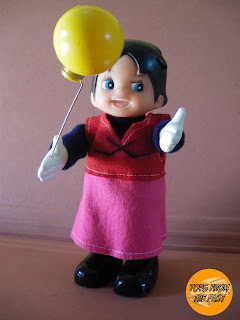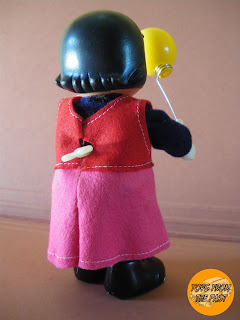Feber Toys (or in Spanish, Juguetes
Feber) is a Spanish toymaker. Currently, Feber is part of the Famosa Holding,
and is specialized in garden plastic houses and motorized vehicles for
children, although it was not always like this.
These two partners would later leave Rosvi (for reasons I do not know, probably, they sold their part of the company), and new partners would take the place of the old ones, and would rename the company Feber after their own names. The new proprietors were the Ferre brothers, José Bernabeu (previously worker of Rosvi) and José Rodríguez Zurita. FEBER: FErre, BErnabeu, Rodríguez.
 |
| This picture is courtesy of Raimundo Payá Moltó - Juguetes Antiguos de Ibi |
The Ferre Brothers would later purchase a pyrotechnic factory, named Pirotécnica Mirafé and based in Ibi, from which Feber had a part. Feber and Mirafé produced toy-pistols with some explosives capsules. In 1968, a terrible accident in this company would kill 33 people. Since it was summer (16th August), many children were working there together with their mothers, mostly without a contract. The Ferre Brothers (Juan and Francisco Ferre Planelles) also died in that accident. Despite the fact that they were working illegally, the Spanish Government provided economic help for all the victims, and a collection of money was started in Ibi together with very moving gestures of solidarity from many different points of Spain.
This type of pistols were banned after the accident, so Feber had to move its production to other toy types, mostly dolls for girls and motorized toys for boys. After the accident and the relatively dark 70s, in the 80s, Feber improved their production and expanded their importance in the national toy market.
It’s in the 80s when Feber designed and launched Chabel, the competitor to Mattel´s Barbie, that was based on a Japanese doll named “Licca” (by Takara) or the super-popular Baby-Feber. Another dolls were Pocas-Pecas or Family Feber. For boys, the most popular toy-line at this time was the Multi-Hobby, different sets of DIY tools, some of them motorized.
In 1989, Feber created Creadisa, their own R&D department, and started their international expansion. In 1990, the popularity was increased enormously after tv commercials hosted by tv-celebrities. By the end of 1991, the company had a turnover of 11500 million pesetas (69 million euros) and employed around 300 people.
Surprinsingly, the following year, Feber had to suspend payments leaving a debt of 6500 million pesetas (39 million euros). After a feasibility plan in 1993, Feber stopped producing dolls and focused on what they’re producing nowadays: outdoor houses and motorized vehicles for children between 1 and 7 years. Their president at the time was José Manuel Rodríguez Ferre, son of the original founder.
In 2006, however, their competitor Famosa took over the company but keep the brand and the production plans, as it can be read in their official website: www.famosa.es
The doll presented today was made around 1976 and represents Heidi, although it is not written anywhere in the box (clearly unlicensed product).The TV-series came to Spain in 1975, and was very popular among children, in a time in which there were only two television channels. It is a clockwork toy (note the “key” in the back of the doll) that walks and moves its hands. It was bought by my father a few months ago, since he found it very charming… and I must agree.
The toy is relatively poor, since we were in 1976 and the company hadn't increased the quality of their products yet. Maybe that adds an extra point of charm!
FACTS and FIGURES:
- Name: HEIDI (Ref. 145) (well, actually this toy doesn't have a name)
- Year: 1976
- Company: Feber (Spain)
- Size of the Figure: Around 20 cm






i'm from spain,i doesn't meet the feber toys,i was borned in the year 2000 but baby feber and chabel from de 80's are aussum.sorry for my english.
ReplyDeleteHola, ¡muchas gracias por el comentario! yo también soy de España, pero escribo en inglés para que lo lea más gente.
DeleteMi hermana tenía Baby Feber y Chabel, las dos, incluyendo muchos accesorios (casa, caravana, dormitorio y cuarto de baño de Chabel y la mesa de baby-Feber que medía como metro y medio de largo). Sobre todo la Chabel es una muñeca excelente, aunque hoy día es muy cara y muy difícil de encontrar.
He visto que tienes un blog muy nuevo, mucha suerte con él y que te diviertas mucho poniendo fotos de tus muñecas.
Un saludo,
Gog/Juan
Gog o Juan,entonces feber después de el accidente y dejar de fabricar pistolas de juguete,que fabricaron?? estos tipos de juguetes mecánicos y ya está??porqué parece que Feber era inexistente,ya que Famosa era líder, y no me suena haber visto ningún juguete de esta empresa anterior a los 80,por eso me extrañaba que en wikipedia pusiera que se fundó en 1956 porqué no conocía ningún juguete muy antiguo.Tienes mmás entradas de juguetes de feber??o de famosa??bueno tendré 12 años pero aparte de barbies,bratzs,monster high entre otras muñecas actuales de mi infancia también me gustan chabel y nancy,y de estas dos solo me falta conseguir una chabel.Si algún día la tuviera y le hiciera una entrada puedes pasarte.
DeleteHola,
DeleteNo, la empresa que tuvo el accidente con la pólvora no fue Feber, sino una "subsidiaria", que es una empresa que se asocia contigo para trabajar en lo mismo, pero que tiene otros dueños.
Feber existe desde efectivamente desde 1956 y yo recuerdo muchos juguetes suyos. En 1989-1990 o así eran la mayor juguetera de España en beneficios, y poco después cerraron por problemas económicos.
Juguetes antiguos de Feber no conozco demasiados, esta muñequita es de lo más antigua que he visto, lo que sí puedo decirte es que Feber produjo siempre todo tipo de juguetes hasta su desaparición, para niños, para niñas, juegos de mesa, peluches, juegos educativos...
Que yo sepa, Feber no tuvo nunca nada que ver con Famosa hasta hace muy muy poco tiempo. Famosa, tradicionalmente sí era líder en muñecas, con Nancy, Barriguitas, Nenuco, Lesly y muchas más, hoy día supongo que ya no lo será.
Famosa también es muy conocida como distribuidora, que quiere decir, que compra el permiso para vender un juguete extranjero en España. Asi llegaron a España los Playmobil (de Alemania), los Micromachines (de U.S.A.), y otros tantos juguetes.
Suerte con esa Chabel, tendrás que ahorrar un poquito para comprar una con sus accesorios, ropas, etc.